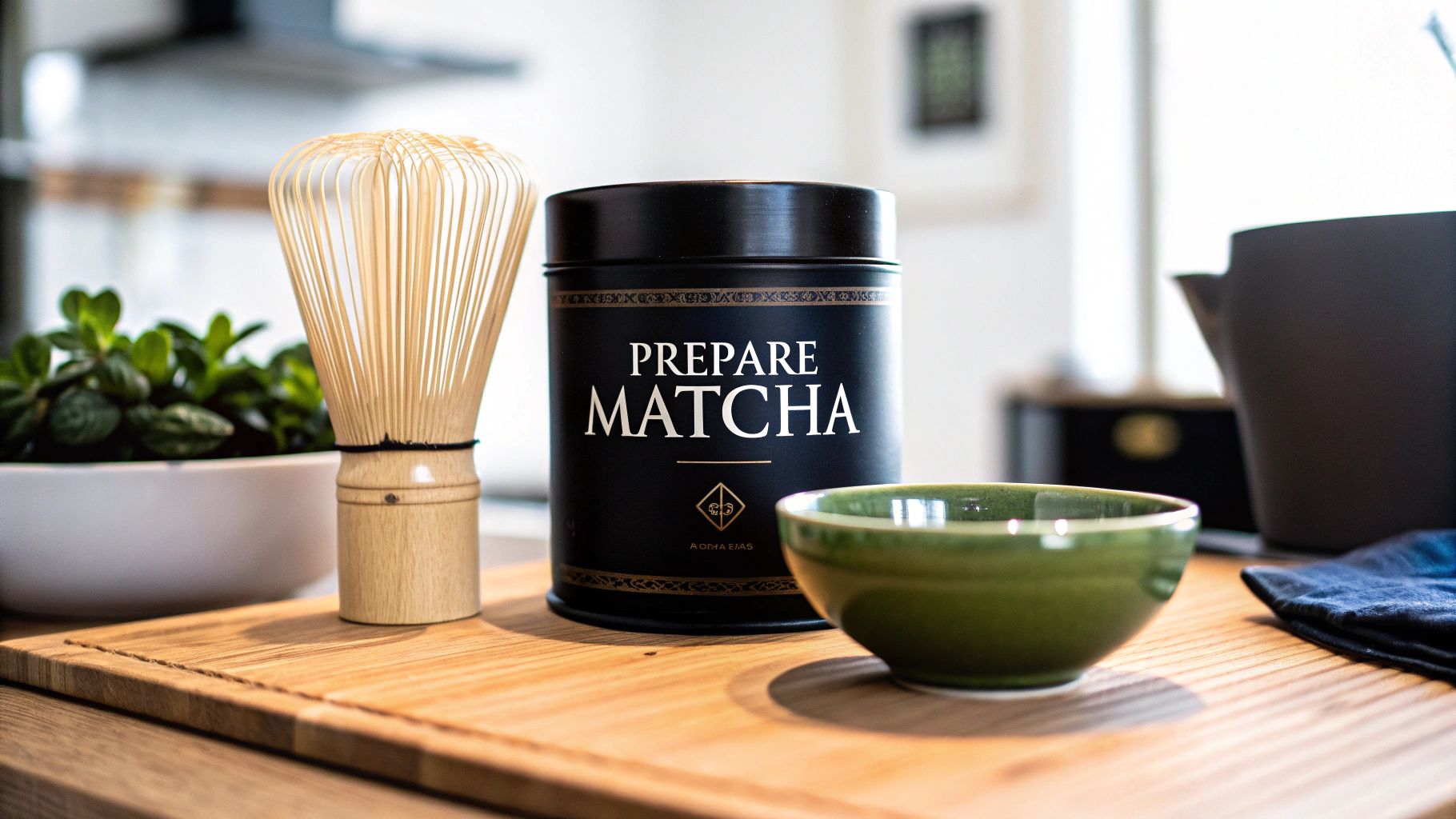Making the perfect bowl of matcha is a simple, mindful ritual. At its heart, you're just whisking a finely ground tea powder with hot water until it’s smooth and frothy. But mastering this simple act is what unlocks matcha’s vibrant, umami-rich flavour, steering you clear of the bitterness that comes from common mistakes, like using water that's far too hot.
Why Getting Your Matcha Preparation Right Matters
Learning how to prepare matcha is about so much more than just following a recipe; it’s about transforming a simple green powder into a mindful, deeply rewarding experience. A poorly made cup is often a bitter, gritty brew that completely misses the point of this incredible tea.
When you get it right, though, matcha offers a smooth, almost creamy texture and a complex, satisfying taste that delivers calm, focused energy. This guide is here to demystify the process and make it accessible for everyone. By paying attention to a few key details—like water temperature and your whisking technique—you'll be creating café-quality matcha at home in no time. For a deeper dive, our step-by-step guide on how to make matcha tea is always there to help.
The Ritual and the Reward
The growing love for this mindful practice is impossible to ignore. The UK matcha market is seeing incredible growth, which really shows how much we're all leaning into wellness rituals. In fact, forecasts show the industry's value is expected to jump from roughly £108 million in 2025 to over £408 million by 2035—that’s a nearly fourfold increase. Discover more insights into the UK matcha market trends.
This surge in popularity isn't just about the taste. It's about what the ritual itself represents: carving out a moment of intention in an otherwise hectic day. You can also tailor your matcha to fit your wellness routine with different blends:
- Amatsu's Pure blend is perfect for that classic, ceremonial matcha experience.
- Radiance is designed with marine collagen for beauty benefits for hair and skin.
- Strength gives you a pre-workout boost for physical performance and recovery.
- Shrooms supports mental clarity and focus with adaptogenic mushrooms.
Mastering your preparation technique ensures you receive the full benefits and flavour from whichever Amatsu Matcha blend you choose, turning your daily cup into a purposeful act of self-care.
Assembling Your Matcha Toolkit
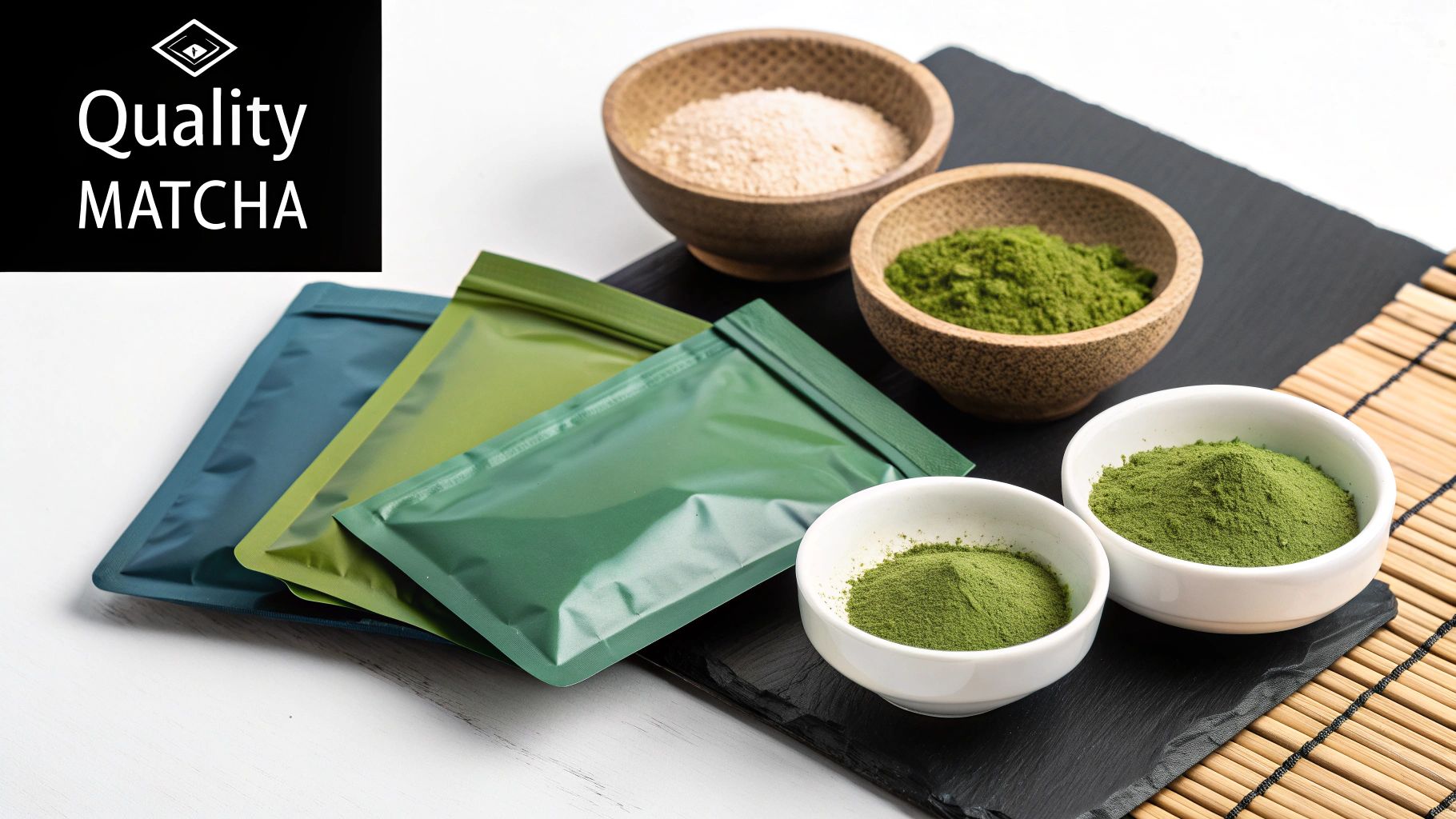
Getting that perfect, café-quality bowl of matcha at home all comes down to your gear. You don't need a huge, elaborate setup, but a few key pieces are absolutely essential for achieving the smooth, frothy texture that makes matcha so special.
Think of it as setting up your own little matcha station. When you start with the right tools, the whole process becomes easier and more enjoyable. It also connects you to the centuries-old ritual behind this incredible drink.
The Traditional Essentials
At the very heart of any matcha kit is the chasen, or bamboo whisk. This isn't just any old whisk. It’s a beautifully crafted tool, often with over 100 delicate tines, designed specifically to aerate the tea and suspend the fine powder in water. Honestly, it's the secret weapon for creating that signature creamy foam and, crucially, avoiding those dreaded clumps.
Then you have the chawan, or matcha bowl. Its wide, flat bottom and high sides aren't just for looks—they’re designed to give you the perfect space for effective whisking. The shape allows the chasen to move freely in that classic 'W' or 'M' pattern. Trying to do this in a regular coffee mug is a recipe for frustration and a weak froth.
Pro Tip: One of the biggest mistakes I see is people trying to stir matcha with a spoon. It just doesn't work. You'll end up with a gritty, clumpy mess. The whisking action of a chasen is what properly emulsifies the powder into the water.
Other traditional tools you’ll often see are:
- A chashaku (bamboo scoop) for measuring out the perfect amount of powder.
- A fine-mesh sifter to break up clumps before you whisk, which is a game-changer for a silky-smooth finish.
Your Matcha Toolkit: Traditional vs. Modern
Choosing your tools is about finding the right balance between tradition and what works for your daily routine. Here’s a quick look at the classic tools and some practical modern stand-ins.
| Tool | Traditional Option | Modern Alternative | Why It Matters |
|---|---|---|---|
| Whisk | Chasen (Bamboo Whisk) | Electric Milk Frother | The chasen creates a delicate micro-foam that’s hard to replicate. A frother is fast but produces larger, airier bubbles. |
| Bowl | Chawan (Matcha Bowl) | Any Wide, Cereal-style Bowl | The chawan's shape is purpose-built for whisking, preventing spills and helping to build a good froth. A regular bowl can work if it's wide enough. |
| Scoop | Chashaku (Bamboo Scoop) | Teaspoon | The chashaku helps measure a consistent dose (about 1g). A ½ teaspoon is a reliable modern equivalent. |
| Sifter | Fine-Mesh Sifter | Small Kitchen Sieve | Sifting is non-negotiable for a clump-free brew. Any small, fine sieve from your kitchen will do the job perfectly. |
Ultimately, whether you go for a full traditional set or mix and match with modern alternatives, the goal is a delicious, smooth bowl of matcha.
Modern Alternatives for When You're Starting Out
If you’re just dipping your toes into the world of matcha and aren't quite ready to buy a full traditional set, a few modern gadgets can bridge the gap. An electric milk frother is easily the most popular stand-in for a bamboo whisk. It’s quick, efficient, and does a great job, especially if you’re making lattes with our Amatsu Pure blend.
While a frother certainly works, it's worth knowing that the foam it creates is usually a bit different—think bigger, airier bubbles rather than the dense, velvety micro-foam you get from a chasen. That traditional whisk really elevates the mouthfeel of the tea.
As for the bowl, any wide-bottomed ceramic bowl from your kitchen can work in a pinch. The most important thing is having enough room to get a good whisking motion going without splashing everywhere.
These modern shortcuts are fantastic for convenience, but as you grow to appreciate the craft of preparing matcha, you’ll probably find that the traditional tools offer a more satisfying and effective ritual. Investing in them doesn't just improve your matcha; it enriches your daily routine with a mindful practice, which beautifully complements the many health benefits of matcha.
The Art of Whisking a Perfect Matcha
With your tools at the ready, you’ve arrived at the heart of the matcha ritual. This is the moment a simple powder transforms into a vibrant, frothy elixir. Honestly, learning how to prepare matcha isn't about complex steps; it's about a few mindful actions that make all the difference between a clumpy, bitter drink and a perfectly smooth, delicious bowl.
The real work begins before you even add water. Sifting your matcha powder is a non-negotiable first step. It breaks up those tiny clumps that form naturally due to static, ensuring your final drink is silky smooth. This small action takes only a few seconds but the payoff in texture is huge.
Another simple but vital habit is to warm your bowl, or chawan. Just pour in a splash of hot water, swirl it around for a moment, and then discard it. This not only warms the vessel but also primes the bamboo whisk, making its delicate tines more pliable and less likely to snap when the real action begins.
Nailing the Powder and Water Ratio
Getting the right balance of matcha to water is absolutely crucial for flavour and consistency. For a traditional bowl, a great starting point is about 2 grams of matcha powder (that’s roughly two bamboo scoops or a level teaspoon) to 70-80ml of hot water. This ratio creates a beautifully balanced usucha, or thin tea.
The temperature of your water is just as important. Boiling water will scorch the delicate tea leaves, leaving you with a harsh, bitter taste. The sweet spot is around 70-80°C. This temperature range is perfect for preserving L-theanine, the amazing compound in matcha linked to that feeling of calm focus.
This visual guide breaks down the essential tools for a traditional matcha preparation.
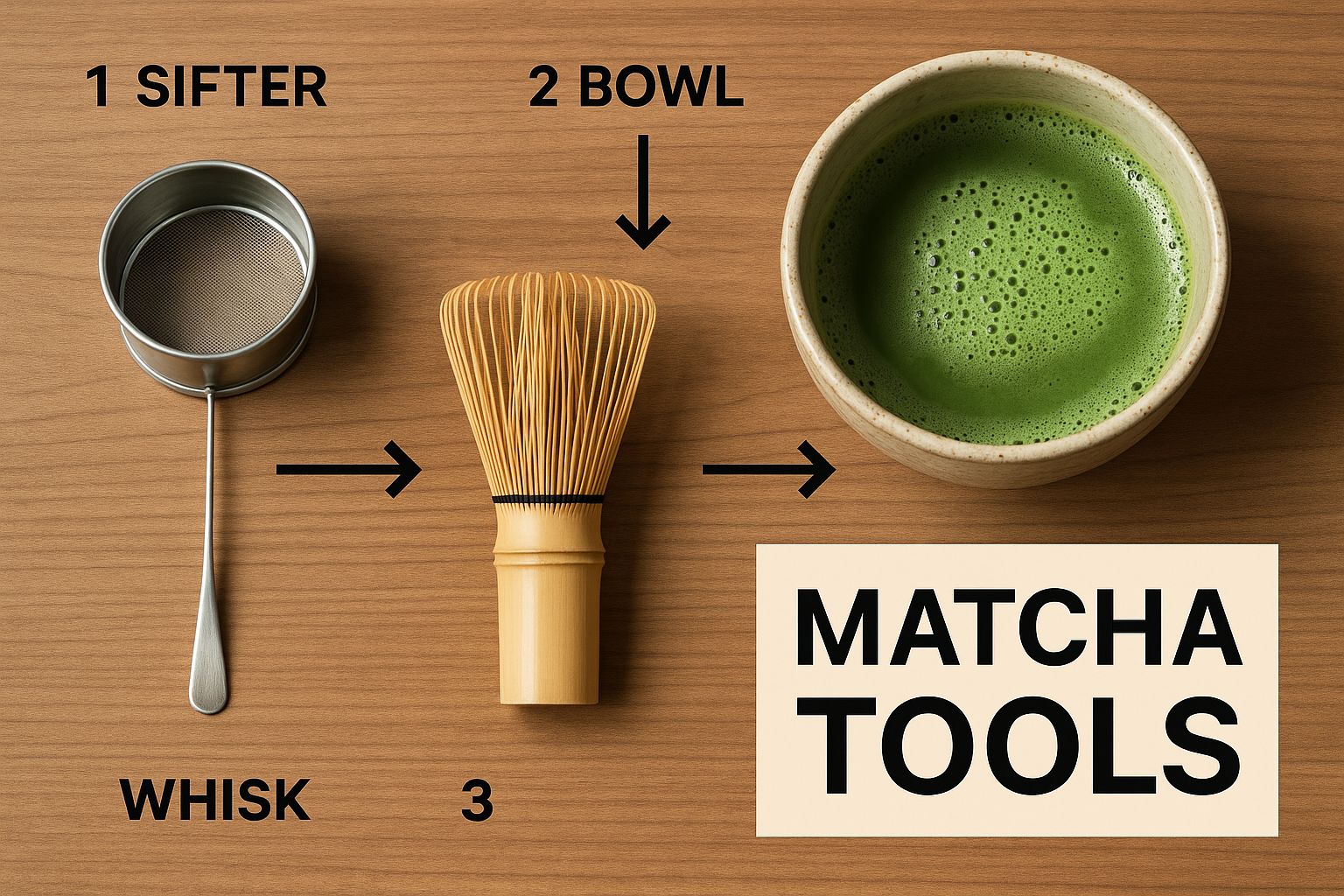
As you can see, the bamboo whisk, sifter, and chawan are central to getting that authentic, high-quality brew we’re all after.
Mastering the Whisking Motion
Now for the main event. Pour your perfectly heated water over the sifted matcha. Holding the bowl steady with one hand, take your bamboo whisk (chasen) in the other. The secret is to whisk with your wrist—not your whole arm—in a rapid zig-zag motion.
Imagine you're drawing a 'W' or an 'M' back and forth across the bottom of the bowl. This energetic movement aerates the tea, suspending the powder evenly in the water and creating that signature rich, creamy froth.
Keep this up for about 20-30 seconds, or until the surface is covered in a layer of fine, velvety foam. As you finish, gently lift the whisk from the centre of the bowl. This little flourish helps create a beautiful peak in the foam. For a closer look, our comprehensive guide has more visual tips on how to whisk matcha effectively to get that perfect micro-foam.
Tailoring Preparation for Your Amatsu Blend
Different blends can benefit from slight tweaks in your technique to really bring out their unique characteristics. Think of these as a starting point:
- For Amatsu Radiance: This blend has a delicate, nuanced flavour. I’d suggest using water on the cooler end of the spectrum, around 70°C, to preserve its subtle notes and the integrity of the marine collagen.
- For Amatsu Strength: To make sure the creatine is fully dissolved, you might want to whisk for a few extra seconds. The robust flavour of this blend also holds up well to a slightly higher water ratio if you fancy a larger drink.
- For Amatsu Pure or Shrooms: Here, the classic 80°C water temperature is ideal. It perfectly unlocks the deep umami flavour of our ceremonial-grade leaves and integrates the functional mushrooms seamlessly.
By mastering these simple actions—sifting, warming, measuring, and whisking—you turn the act of making tea into a truly rewarding daily ritual.
Troubleshooting Your Matcha: A Few Common Hiccups
Even seasoned matcha lovers have off days. If your bowl turns out bitter, lumpy, or disappointingly flat, don’t worry – you're in good company. These little issues are common when you're starting out, but the good news is they're incredibly easy to fix once you know what to look for.
Think of it less like a failure and more like a conversation with your tea. Each little imperfection is a clue, pointing you towards a small tweak in your technique. Let's diagnose the usual suspects and get you one step closer to that perfect, vibrant bowl every single time.
Why Does My Matcha Taste Bitter?
If your matcha has a harsh, bitter bite, the number one culprit is almost always the water temperature. Water that’s too hot, especially straight from a rolling boil, will literally scorch the delicate tea leaves. This burns off all the complex, sweet notes and floods your bowl with bitter-tasting catechins.
The sweet spot is somewhere between 70-80°C. Don't have a fancy variable-temperature kettle? No problem. Here’s a simple workaround I use all the time:
- Boil your water as you normally would.
- Pour it into your matcha bowl to warm it up.
- Let it sit for a good 3-5 minutes to cool down before you add the matcha powder.
That little pause is a game-changer. It’s what protects the nuanced, umami-rich flavour of a high-quality powder, like our Amatsu blends.
How to Get Rid of Those Pesky Clumps
Ever get to the bottom of your bowl and find a gritty surprise? Those little clumps mean the powder never fully suspended in the water. This usually boils down to one of two things: you skipped the sifter, or your whisking wasn't quite vigorous enough.
Sifting your matcha through a fine-mesh sieve before adding water is, in my opinion, non-negotiable for a silky-smooth finish. It breaks up any tiny clumps that form due to static and humidity, letting the powder dissolve beautifully. It takes ten seconds but completely transforms the final texture.
A common mistake is thinking a quick stir with a spoon will do the trick. It won't. It’s the rapid, zig-zag motion of a proper whisk that truly emulsifies the matcha, creating a perfectly integrated, smooth drink.
The traditional method, refined over centuries, involves whisking 1-2 grams of powder with about 70 ml of water heated to that crucial 80°C mark. This meticulous approach is key to unlocking the perfect flavour.
Achieving That Perfect Frothy Top
Is your matcha looking a bit flat and lifeless, with no creamy foam on top? The problem is almost certainly in your whisking technique. A weak froth usually means you’re either whisking too slowly or just stirring in circles.
The secret is to use your wrist, not your whole arm. Snap it back and forth in a quick 'W' or 'M' pattern across the bottom of the bowl. This movement is what whips air into the liquid, building that beautiful layer of micro-foam. Make sure you’re using a wide-bottomed bowl, too—it gives you the space you need to get the whisk moving properly.
And if you're applying these tips to lattes, our guide on how to make a matcha latte has some great pointers for getting that perfect foam on milk-based drinks.
Creative Ways to Enjoy Your Matcha
Once you’ve mastered the traditional bowl of matcha, a whole new world of possibilities opens up. Its uniquely earthy, vibrant flavour is surprisingly versatile, working beautifully in everything from creamy lattes to energising smoothies.
Think of your daily matcha ritual as more than just making tea—it's about creating a foundational ingredient for your entire wellness routine. By learning a few new ways to prepare it, you can tailor its benefits to exactly what you need, whether that's a gentle morning lift or a serious pre-workout boost. It's time to take matcha beyond the bowl.
Crafting the Perfect Matcha Latte
The matcha latte has become a modern classic for good reason. It’s comforting, creamy, and gives you a clean energy boost that feels worlds away from a coffee buzz. It's a simple twist on the traditional method, creating a drink that feels both indulgent and nourishing.
For a truly fantastic latte, I always reach for our Amatsu Matcha Pure. Its robust, classic flavour profile is strong enough to shine through, even when mixed with milk.
To get that café-quality result at home, the trick is to start by making a concentrated matcha "shot."
- First, sift 1 teaspoon of Amatsu Matcha Pure into your bowl or mug. Don't skip this—it’s the secret to a silky-smooth texture with zero clumps.
- Next, pour in about 60ml of hot water. You're aiming for around 80°C, so definitely not boiling.
- Now, grab your bamboo whisk (or an electric frother) and whisk vigorously in a quick zig-zag motion. You're looking for a thick, frothy paste to form. This concentrated base is what makes a latte rich and flavourful, not watery.
With your matcha shot ready, simply top it up with 180-200ml of your favourite steamed milk. Oat, almond, and dairy all work wonderfully here. For an iced latte, just pour the matcha shot over a glass full of ice and top it with cold milk. Easy.
Pro Tip for Latte Art: Want to get fancy? Creating beautiful latte art is all about the micro-foam. When you're frothing your milk, keep the steam wand just below the surface to create a gentle vortex. The goal is a texture like wet paint, not big bubbles. This will give you that perfect canvas for pouring elegant designs.
The Ultimate Performance-Boosting Smoothie
On days when you need an extra edge, a matcha-powered smoothie is an absolute game-changer. This isn't just about flavour; it's about functional nutrition. By using one of our specialised blends, you can turn a simple smoothie into a real powerhouse.
Amatsu’s Strength blend, fortified with creatine, is my go-to for pre-workout fuel. For those long days at my desk, I'll use our Shrooms blend, which has adaptogenic mushrooms to help with sustained focus and mental clarity.
Here’s a simple recipe that's both effective and delicious:
- 1 banana (I always use a frozen one for a creamier, thicker texture)
- A large handful of spinach (you won't taste it, I promise)
- 1 scoop of Amatsu Matcha Strength or Shrooms
- 1 scoop of vanilla protein powder (optional, but great for recovery)
- 250ml of almond milk or water
- 1 tablespoon of chia seeds or almond butter for some healthy fats
Just throw everything into a blender and blitz until it's completely smooth. The frozen banana is key—it creates a thick, milkshake-like consistency without watering down the matcha flavour.
If you're looking for even more ideas, we've put together a full guide on how to use matcha powder in all sorts of creative and tasty ways.
Your Matcha Questions, Answered
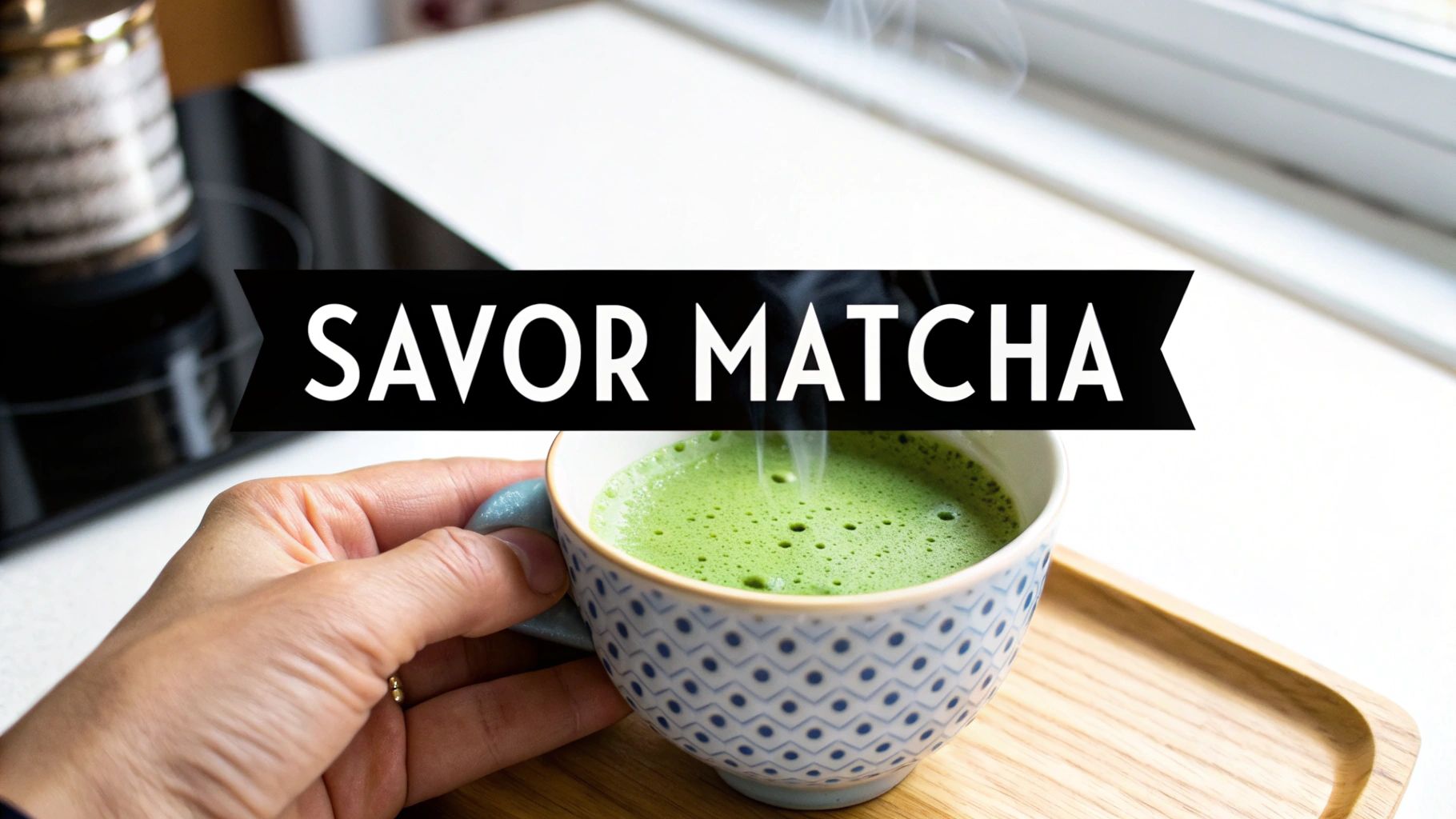
Jumping into the world of matcha can bring up a few questions. That's completely normal! With a little guidance, you’ll be perfecting your technique in no time. Here are some quick, clear answers to the queries we hear most often from people learning how to prepare matcha at home.
What’s the Ideal Water Temperature for Preparing Matcha?
For the best flavour, you’ll want your water to be between 70-80°C (160-175°F). This is a crucial detail. If you use water that's at a rolling boil, you'll scorch the delicate tea leaves, which is exactly what causes that unpleasantly bitter taste.
Don't have a variable-temperature kettle? No problem. There's an easy trick I use all the time: just boil your water and then let it sit for about 3-5 minutes to cool down. This simple pause is honestly one of the most important steps for unlocking the sweet, umami notes of a high-quality matcha.
Can I Prepare Matcha Without a Bamboo Whisk?
While the traditional bamboo whisk, or chasen, is definitely the best tool for creating that perfect, creamy froth, you can absolutely make matcha without one. An electric milk frother is a great modern alternative, and it's particularly handy if you're making lattes.
In a pinch, a small kitchen whisk can also get the job done. Just be aware that the chasen's unique design, with its hundred-plus fine tines, is specifically crafted to suspend the powder evenly and generate the signature micro-foam of a traditional bowl of matcha.
The right tool really does make a difference. While alternatives work, the bamboo whisk is purpose-built to create the authentic texture and mouthfeel that makes matcha so special.
How Should I Store My Matcha Powder to Keep It Fresh?
Matcha is quite sensitive. Light, heat, and air will all degrade its vibrant green colour and rich flavour over time. To protect its quality, always store your Amatsu Matcha in its airtight container in a cool, dark place, like a cupboard.
For longer-term storage, an unopened tin can be kept in the fridge. But once you've opened it, I strongly recommend using the powder within 4-6 weeks to enjoy its best taste and potency.
Which Amatsu Matcha Blend Is Right for Me?
Choosing your ideal blend really just comes down to personal taste and what you're hoping to achieve. We've designed each of our formulas with a specific purpose in mind:
- Pure: Go for this one if you want a classic, ceremonial tea experience with a deep umami flavour. It's the perfect all-rounder for lattes and traditional preparation.
- Radiance: This is your blend for beauty benefits. It targets healthy hair and skin with added marine collagen.
- Shrooms: Looking for better mental clarity and focus? This blend features functional adaptogenic mushrooms to help you power through your day.
- Strength: Choose this for a pre-workout energy lift and to support physical performance and recovery, thanks to added creatine.
Ready to create your own perfect matcha ritual? Explore the full collection at Amatsu Matcha and find the blend that feels right for your wellness journey. You'll quickly discover the difference that ceremonial-grade quality makes.
Read more
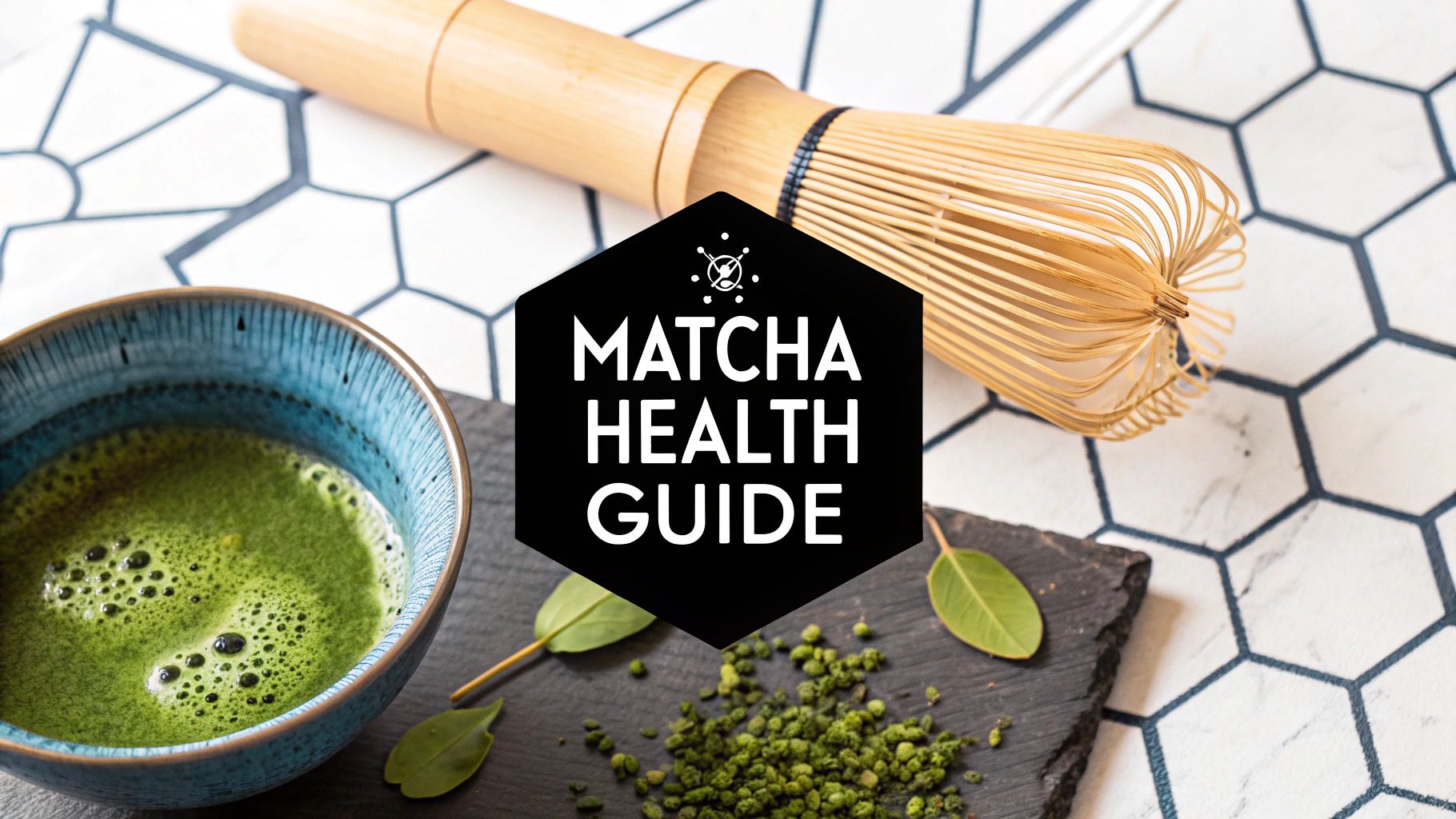
Discover the science-backed matcha health benefits, from calm energy to improved wellness. Learn how matcha can transform your daily health routine.
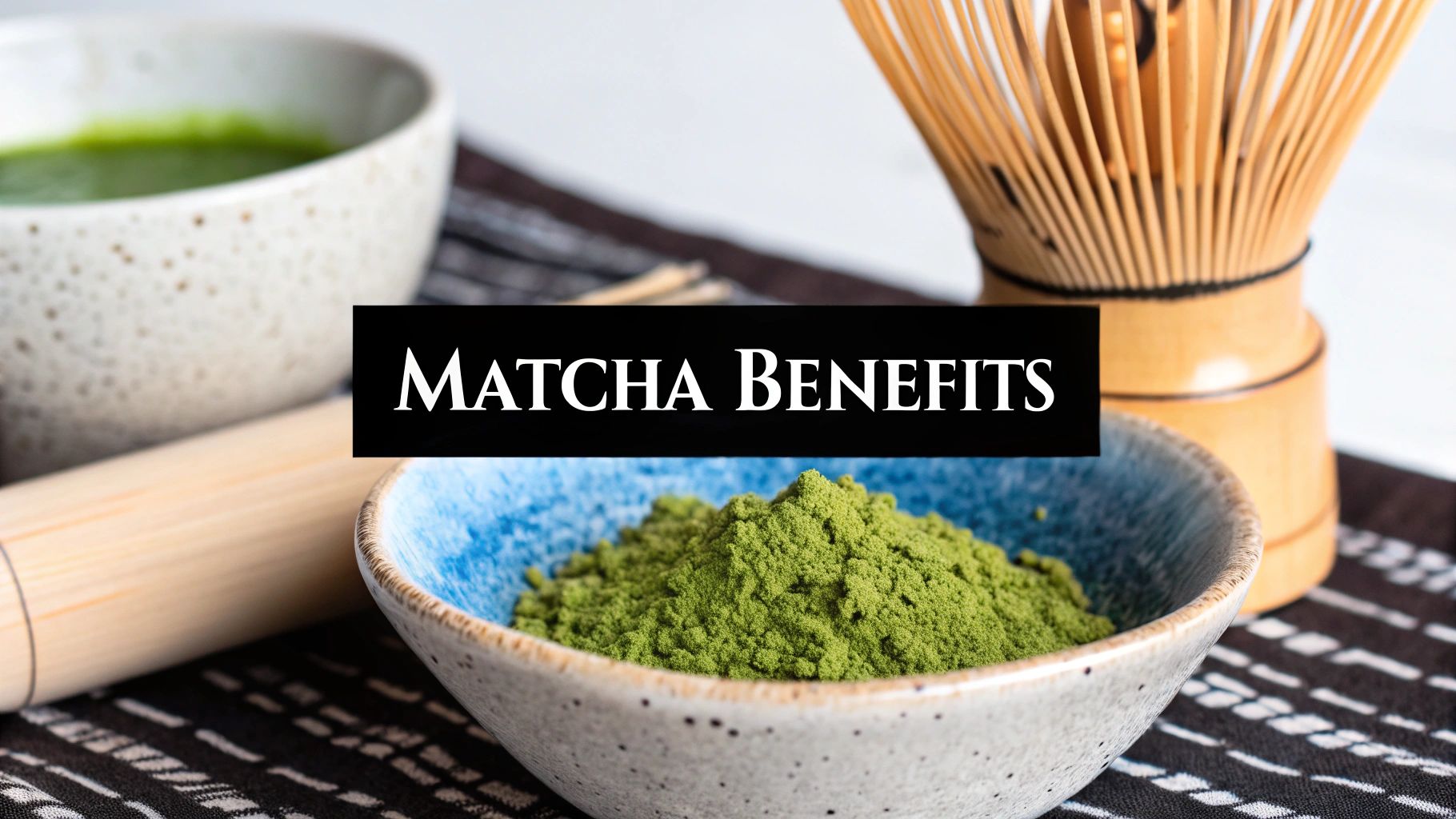
Discover the matcha powder health benefits that can transform your wellness. Explore antioxidants, calm energy, and how to boost your daily health.
